

Dis Pater. Defixio tablet (mid-first century B.C.) invoking Dis pater for a binding spell It is often thought that Dis Pater was also a Celtic god.
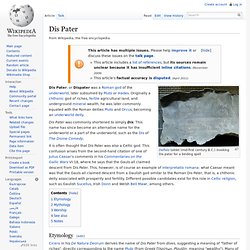
This confusion arises from the second-hand citation of one of Julius Caesar's comments in his Commentaries on the Gallic Wars VI:18, where he says that the Gauls all claimed descent from Dis Pater. This, however, is of course an example of interpretatio romana: what Caesar meant was that the Gauls all claimed descent from a Gaulish god similar to the Roman Dis Pater, that is, a chthonic deity associated with prosperity and fertility. Different possible candidates exist for this role in Celtic religion, such as Gaulish Sucellus, Irish Donn and Welsh Beli Mawr, among others.
Etymology[edit] Mythology[edit] Worship[edit] In 249 BC and 207 BC, the Roman Senate under Senator Lucius Catelli ordained special festivals to appease Dis Pater and Proserpina. Erebus. In Greek literature the name Erebus is also used of a region of the Greek underworld where the dead pass immediately after dying, and is sometimes used interchangeably with Tartarus.[3][4][5][6][7] The perceived meaning of Erebus is "darkness"; the first recorded instance of it was "place of darkness between earth and Hades".
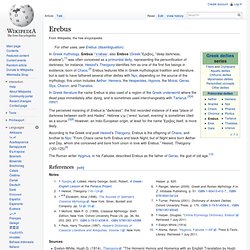
Hebrew עֶרֶב (ˤerev) 'sunset, evening' is sometimes cited as a source.[3][8] However, an Indo-European origin, at least for the name Ἔρεβος itself, is more likely. The Roman writer Hyginus, in his Fabulae, described Erebus as the father of Geras, the god of old age.[10] References[edit] Notes Jump up ^ Ἔρεβος. Sources External links[edit] Hades. Names and epithets As with almost every name for the gods, the origin of Hades's name is obscure.
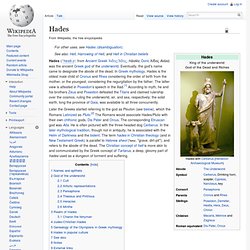
The name as it came to be known in classical times was Ἅιδης, Hāidēs. Later the iota became silent.[3] Originally it was *Awides which has been claimed to mean "unseen".[4] This changed into Ἀΐδης, Aïdēs (and afterwards Āïdēs), with the dropping of the digamma. Hecate. Ancient Greek goddess of magic and crossroads Hecate was one of the main deities worshiped in Athenian households as a protective goddess and one who bestowed prosperity and daily blessings on the family.[5] In the post-Christian writings of the Chaldean Oracles (2nd–3rd century CE) she was regarded with (some) rulership over earth, sea, and sky, as well as a more universal role as Savior (Soteira), Mother of Angels and the Cosmic World Soul.[6][7] Regarding the nature of her cult, it has been remarked, "she is more at home on the fringes than in the center of Greek polytheism.

Intrinsically ambivalent and polymorphous, she straddles conventional boundaries and eludes definition. Macaria. Macaria or Makaria (Greek Μακαρία) is the name of two figures from ancient Greek religion and mythology.
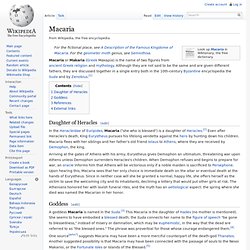
Although they are not said to be the same and are given different fathers, they are discussed together in a single entry both in the 10th-century Byzantine encyclopedia the Suda and by Zenobius.[1] Daughter of Heracles[edit] Arriving at the gates of Athens with his army, Eurystheus gives Demophon an ultimatum, threatening war upon Athens unless Demophon surrenders Heracles's children. When Demophon refuses and begins to prepare for war, an oracle informs him that Athens will be victorious only if a noble maiden is sacrificed to Persephone. Melinoe. Name[edit] Melinoë may derive from Greek mēlinos (μήλινος), "having the color of quince," from mēlon (μῆλον), "tree fruit".[6] The fruit's yellowish-green color evoked the pallor of illness or death for the Greeks.
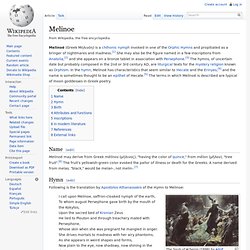
A name derived from melas, "black," would be melan-, not melin-.[7] Mors (mythology) Mors (Death) coming for a miser in a painting by Bosch Mors is often represented allegorically in later Western literature and art, particularly during the Middle Ages.

Orcus. Origins The origins of Orcus may have lain in Etruscan religion.

The so-called Tomb of Orcus, an Etruscan site at Tarquinia, is a misnomer, resulting from its first discoverers mistaking as Orcus a hairy, bearded giant that was actually a figure of a Cyclops. Orcus was chiefly worshipped in rural areas; he had no official cult in the cities.[1] This remoteness allowed for him to survive in the countryside long after the more prevalent gods had ceased to be worshipped. He survived as a folk figure into the Middle Ages, and aspects of his worship were transmuted into the wild man festivals held in rural parts of Europe through modern times.[1] Indeed, much of what is known about the celebrations associated with Orcus come from medieval sources.[1] Survival and later use This orco was the inspiration to J.
Note. Also, in an unpublished letter sent to Gene Wolfe, Tolkien also made this comment:[2] See also Notes References Bernheimer, Richard (1952). External links. Persephone. Pluto (mythology) God in Greek mythology Pluton (1884–86) by Henri Chapu, part of a pair with a standing Persephone gathering flowers Hydria (ca. 340 BC) depicting figures from the Eleusinian Mysteries Plouton with cornucopia (Attic red-figure amphora, ca. 470 BC)
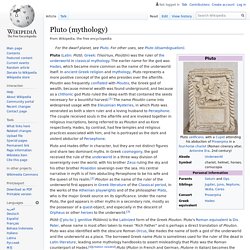
Thanatos. In myth and poetry "And there the children of dark Night have their dwellings, Sleep and Death, awful gods.
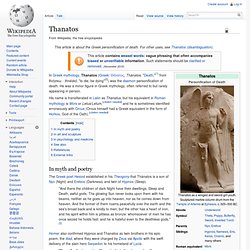
The glowing Sun never looks upon them with his beams, neither as he goes up into heaven, nor as he comes down from heaven.